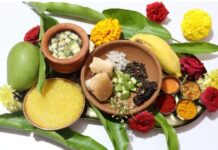Sankranthi, also known as Makar Sankranti, is a Hindu festival celebrated in India and other parts of South Asia. It marks the transition of the Sun into the zodiac sign of Capricorn (Makara) and is usually observed on January 14th or 15th. The festival is significant as it signifies the end of winter and the beginning of longer days.
Sankranthi is celebrated with various regional customs and traditions across India. People often take ritualistic baths in rivers, give thanks to the Sun God, and participate in cultural events. Flying kites is a popular tradition during this festival in some regions, and special foods are prepared to mark the occasion. In different states of India, the festival is known by different names, such as Pongal in Tamil Nadu, Lohri in Punjab, Uttarayan in Gujarat, and Magh Bihu in Assam.
Overall, Sankranthi is a festival that symbolizes the importance of harvest, nature, and the changing seasons in Hindu culture. The way it is celebrated may vary from region to region, but the essence of expressing gratitude for the harvest and welcoming the new season remains consistent.
Sankranthi, also known as Makar Sankranti, holds significant cultural, religious, and agricultural importance in India. Here are some key aspects of its significance:
- Harvest Festival: Sankranthi is primarily a harvest festival, marking the end of the winter season and the onset of longer days. It is a time to celebrate the bountiful harvest and express gratitude to the Sun God for providing energy and warmth to the crops.
- Solar Transition: The festival is linked to the movement of the sun into the zodiac sign of Capricorn (Makara). This transition is considered auspicious and is believed to bring positive energy and spiritual growth. The Sun’s movement northward is also seen as a symbol of the increasing light and warmth.
- Cultural Diversity: Sankranthi is celebrated with diverse customs and traditions across different states of India. Each region has its own unique way of observing the festival, adding to the rich cultural tapestry of the country.
- Festive Traditions: People celebrate Sankranthi by taking ritualistic baths in rivers, offering prayers to the Sun God, and participating in cultural events. Flying kites is a popular tradition in some regions, symbolizing the victory of light over darkness.
- Special Foods: Various delicious dishes are prepared during Sankranthi, with ingredients typically associated with the harvest. In South India, the festival is known as Pongal, and a special dish called Pongal is cooked using freshly harvested rice, jaggery, and other ingredients.
- Community Bonding: Sankranthi brings families and communities together. People visit each other’s homes, exchange greetings, and share festive meals. It strengthens social bonds and promotes a sense of unity and joy.
- Cattle Worship: In some regions, cattle, particularly cows, are honored during Sankranthi. They are decorated, and prayers are offered to them as a symbol of gratitude for their contribution to agriculture.
- Auspicious Time for Rituals: Many people consider Sankranthi as an auspicious time for starting new ventures and performing religious rituals. It is believed that any good deed or religious act performed during this period brings prosperity and blessings.
In summary, Sankranthi is a multifaceted festival that encompasses agricultural festivities, cultural celebrations, and religious observances. It reflects the close connection between nature, spirituality, and the cultural diversity of India.














